Leadership and Management Report: Analyzing Angela's Leadership Styles
VerifiedAdded on 2020/09/17
|15
|5197
|33
Report
AI Summary
This report presents an analysis of leadership and management principles, focusing on a case study involving Angela, an associate director in a non-profit organization. The report delves into various leadership theories, including the Great Man Theory, Trait Theory, Contingency Theory, and Situational Theory, exploring their characteristics and applications. It examines different leadership styles such as directing, coaching, supporting, and delegating, alongside behavioral, participative, management, and transformational theories. The analysis addresses specific questions related to Angela's role, her leadership style, and strategies for building staff confidence and improving team performance. The report emphasizes the importance of aligning leadership skills with the organization's mission and communicating effectively to enhance morale and departmental direction. It provides insights into how managers can ascertain their individual skills, and how to provide proper support to the employees. The report also highlights the challenges faced in the non-profit sector, such as staff turnover and the need for effective communication and professional development.
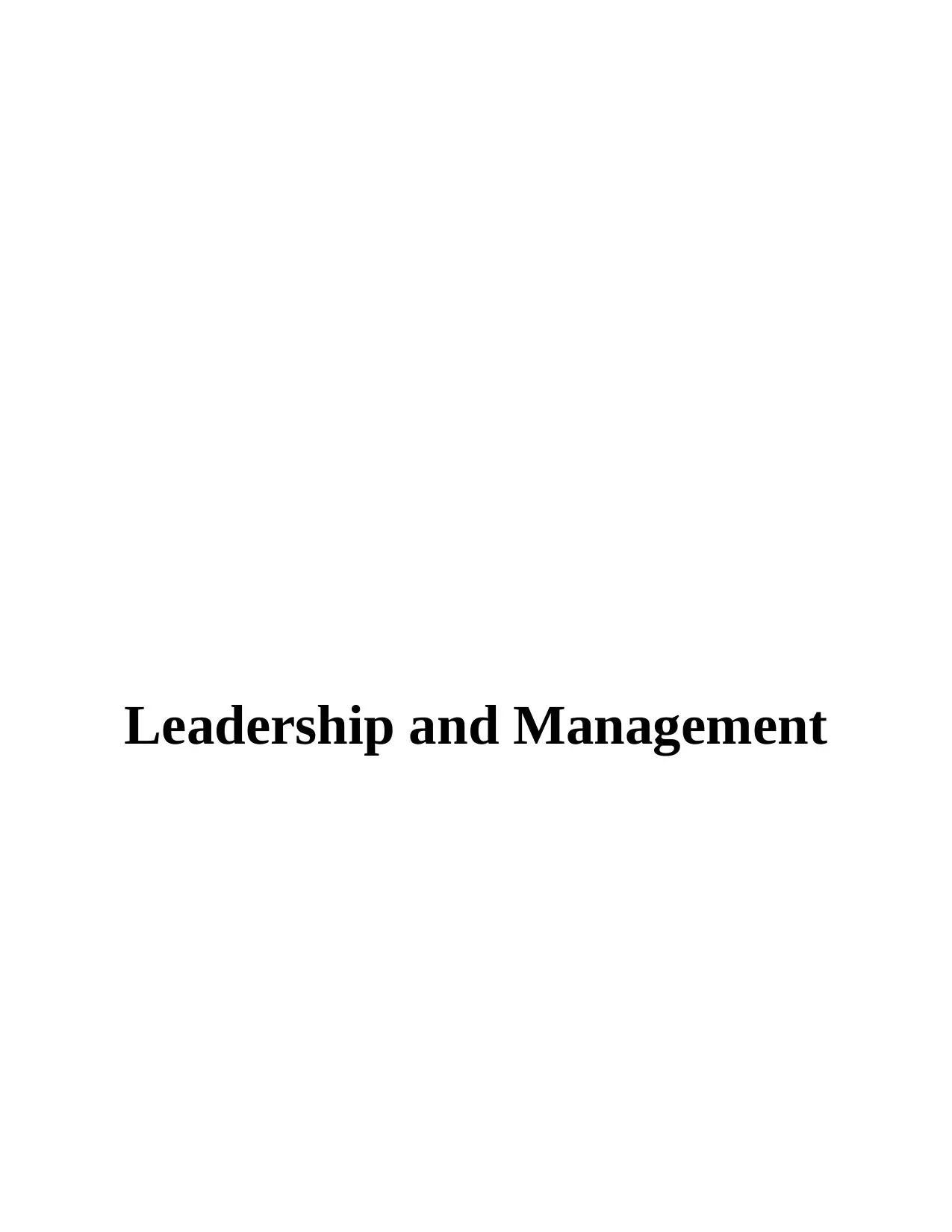
Leadership and Management
Paraphrase This Document
Need a fresh take? Get an instant paraphrase of this document with our AI Paraphraser
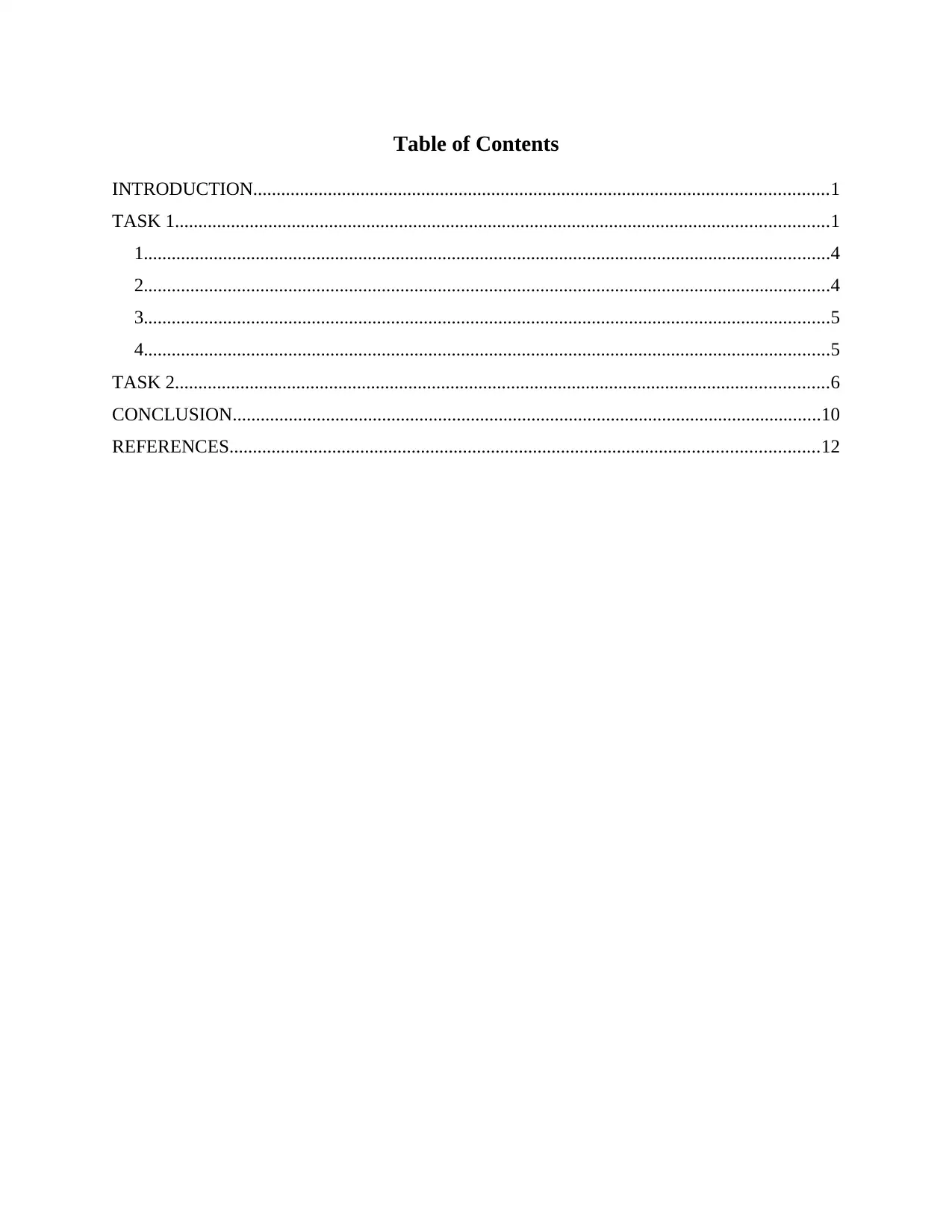
Table of Contents
INTRODUCTION...........................................................................................................................1
TASK 1............................................................................................................................................1
1...................................................................................................................................................4
2...................................................................................................................................................4
3...................................................................................................................................................5
4...................................................................................................................................................5
TASK 2............................................................................................................................................6
CONCLUSION..............................................................................................................................10
REFERENCES..............................................................................................................................12
INTRODUCTION...........................................................................................................................1
TASK 1............................................................................................................................................1
1...................................................................................................................................................4
2...................................................................................................................................................4
3...................................................................................................................................................5
4...................................................................................................................................................5
TASK 2............................................................................................................................................6
CONCLUSION..............................................................................................................................10
REFERENCES..............................................................................................................................12
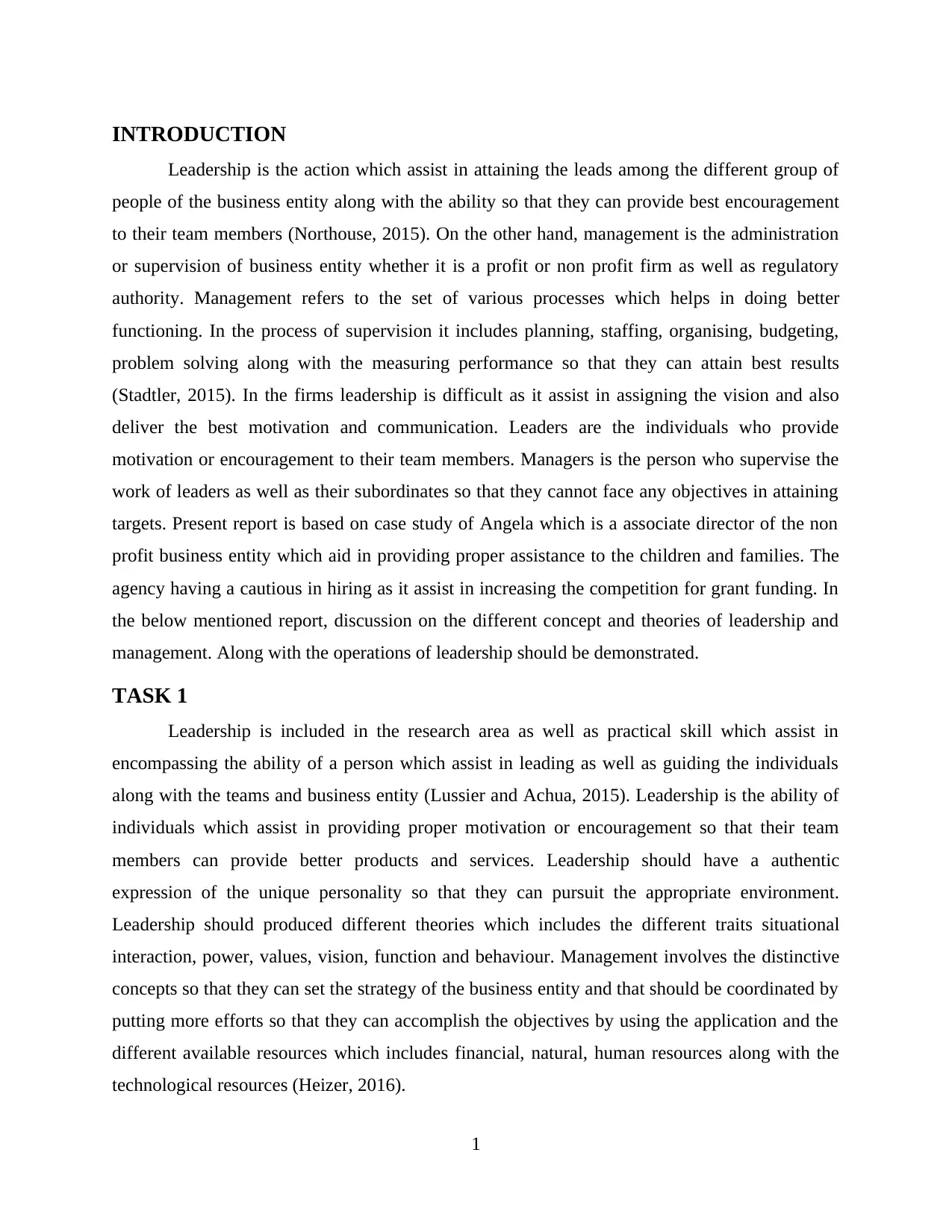
INTRODUCTION
Leadership is the action which assist in attaining the leads among the different group of
people of the business entity along with the ability so that they can provide best encouragement
to their team members (Northouse, 2015). On the other hand, management is the administration
or supervision of business entity whether it is a profit or non profit firm as well as regulatory
authority. Management refers to the set of various processes which helps in doing better
functioning. In the process of supervision it includes planning, staffing, organising, budgeting,
problem solving along with the measuring performance so that they can attain best results
(Stadtler, 2015). In the firms leadership is difficult as it assist in assigning the vision and also
deliver the best motivation and communication. Leaders are the individuals who provide
motivation or encouragement to their team members. Managers is the person who supervise the
work of leaders as well as their subordinates so that they cannot face any objectives in attaining
targets. Present report is based on case study of Angela which is a associate director of the non
profit business entity which aid in providing proper assistance to the children and families. The
agency having a cautious in hiring as it assist in increasing the competition for grant funding. In
the below mentioned report, discussion on the different concept and theories of leadership and
management. Along with the operations of leadership should be demonstrated.
TASK 1
Leadership is included in the research area as well as practical skill which assist in
encompassing the ability of a person which assist in leading as well as guiding the individuals
along with the teams and business entity (Lussier and Achua, 2015). Leadership is the ability of
individuals which assist in providing proper motivation or encouragement so that their team
members can provide better products and services. Leadership should have a authentic
expression of the unique personality so that they can pursuit the appropriate environment.
Leadership should produced different theories which includes the different traits situational
interaction, power, values, vision, function and behaviour. Management involves the distinctive
concepts so that they can set the strategy of the business entity and that should be coordinated by
putting more efforts so that they can accomplish the objectives by using the application and the
different available resources which includes financial, natural, human resources along with the
technological resources (Heizer, 2016).
1
Leadership is the action which assist in attaining the leads among the different group of
people of the business entity along with the ability so that they can provide best encouragement
to their team members (Northouse, 2015). On the other hand, management is the administration
or supervision of business entity whether it is a profit or non profit firm as well as regulatory
authority. Management refers to the set of various processes which helps in doing better
functioning. In the process of supervision it includes planning, staffing, organising, budgeting,
problem solving along with the measuring performance so that they can attain best results
(Stadtler, 2015). In the firms leadership is difficult as it assist in assigning the vision and also
deliver the best motivation and communication. Leaders are the individuals who provide
motivation or encouragement to their team members. Managers is the person who supervise the
work of leaders as well as their subordinates so that they cannot face any objectives in attaining
targets. Present report is based on case study of Angela which is a associate director of the non
profit business entity which aid in providing proper assistance to the children and families. The
agency having a cautious in hiring as it assist in increasing the competition for grant funding. In
the below mentioned report, discussion on the different concept and theories of leadership and
management. Along with the operations of leadership should be demonstrated.
TASK 1
Leadership is included in the research area as well as practical skill which assist in
encompassing the ability of a person which assist in leading as well as guiding the individuals
along with the teams and business entity (Lussier and Achua, 2015). Leadership is the ability of
individuals which assist in providing proper motivation or encouragement so that their team
members can provide better products and services. Leadership should have a authentic
expression of the unique personality so that they can pursuit the appropriate environment.
Leadership should produced different theories which includes the different traits situational
interaction, power, values, vision, function and behaviour. Management involves the distinctive
concepts so that they can set the strategy of the business entity and that should be coordinated by
putting more efforts so that they can accomplish the objectives by using the application and the
different available resources which includes financial, natural, human resources along with the
technological resources (Heizer, 2016).
1
⊘ This is a preview!⊘
Do you want full access?
Subscribe today to unlock all pages.

Trusted by 1+ million students worldwide
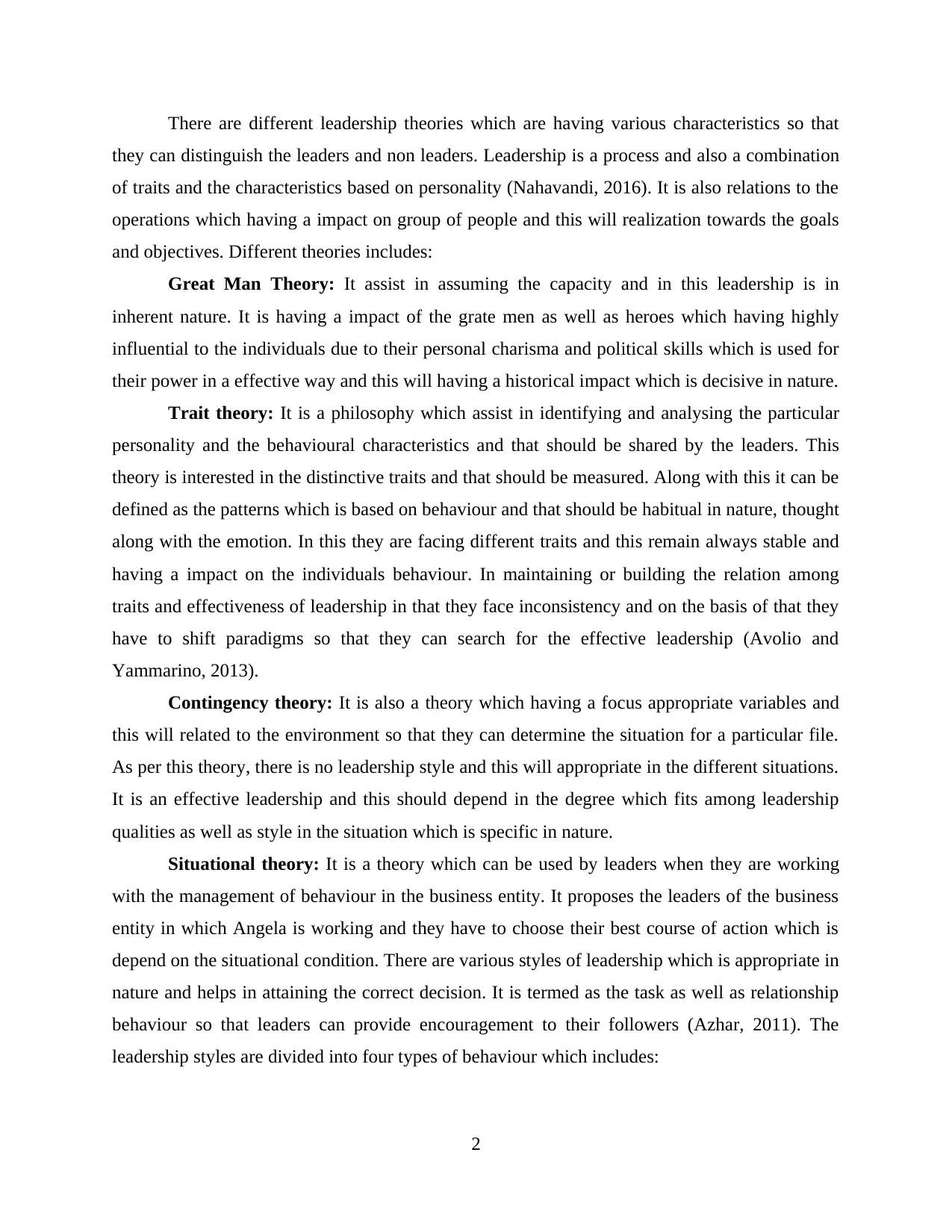
There are different leadership theories which are having various characteristics so that
they can distinguish the leaders and non leaders. Leadership is a process and also a combination
of traits and the characteristics based on personality (Nahavandi, 2016). It is also relations to the
operations which having a impact on group of people and this will realization towards the goals
and objectives. Different theories includes:
Great Man Theory: It assist in assuming the capacity and in this leadership is in
inherent nature. It is having a impact of the grate men as well as heroes which having highly
influential to the individuals due to their personal charisma and political skills which is used for
their power in a effective way and this will having a historical impact which is decisive in nature.
Trait theory: It is a philosophy which assist in identifying and analysing the particular
personality and the behavioural characteristics and that should be shared by the leaders. This
theory is interested in the distinctive traits and that should be measured. Along with this it can be
defined as the patterns which is based on behaviour and that should be habitual in nature, thought
along with the emotion. In this they are facing different traits and this remain always stable and
having a impact on the individuals behaviour. In maintaining or building the relation among
traits and effectiveness of leadership in that they face inconsistency and on the basis of that they
have to shift paradigms so that they can search for the effective leadership (Avolio and
Yammarino, 2013).
Contingency theory: It is also a theory which having a focus appropriate variables and
this will related to the environment so that they can determine the situation for a particular file.
As per this theory, there is no leadership style and this will appropriate in the different situations.
It is an effective leadership and this should depend in the degree which fits among leadership
qualities as well as style in the situation which is specific in nature.
Situational theory: It is a theory which can be used by leaders when they are working
with the management of behaviour in the business entity. It proposes the leaders of the business
entity in which Angela is working and they have to choose their best course of action which is
depend on the situational condition. There are various styles of leadership which is appropriate in
nature and helps in attaining the correct decision. It is termed as the task as well as relationship
behaviour so that leaders can provide encouragement to their followers (Azhar, 2011). The
leadership styles are divided into four types of behaviour which includes:
2
they can distinguish the leaders and non leaders. Leadership is a process and also a combination
of traits and the characteristics based on personality (Nahavandi, 2016). It is also relations to the
operations which having a impact on group of people and this will realization towards the goals
and objectives. Different theories includes:
Great Man Theory: It assist in assuming the capacity and in this leadership is in
inherent nature. It is having a impact of the grate men as well as heroes which having highly
influential to the individuals due to their personal charisma and political skills which is used for
their power in a effective way and this will having a historical impact which is decisive in nature.
Trait theory: It is a philosophy which assist in identifying and analysing the particular
personality and the behavioural characteristics and that should be shared by the leaders. This
theory is interested in the distinctive traits and that should be measured. Along with this it can be
defined as the patterns which is based on behaviour and that should be habitual in nature, thought
along with the emotion. In this they are facing different traits and this remain always stable and
having a impact on the individuals behaviour. In maintaining or building the relation among
traits and effectiveness of leadership in that they face inconsistency and on the basis of that they
have to shift paradigms so that they can search for the effective leadership (Avolio and
Yammarino, 2013).
Contingency theory: It is also a theory which having a focus appropriate variables and
this will related to the environment so that they can determine the situation for a particular file.
As per this theory, there is no leadership style and this will appropriate in the different situations.
It is an effective leadership and this should depend in the degree which fits among leadership
qualities as well as style in the situation which is specific in nature.
Situational theory: It is a theory which can be used by leaders when they are working
with the management of behaviour in the business entity. It proposes the leaders of the business
entity in which Angela is working and they have to choose their best course of action which is
depend on the situational condition. There are various styles of leadership which is appropriate in
nature and helps in attaining the correct decision. It is termed as the task as well as relationship
behaviour so that leaders can provide encouragement to their followers (Azhar, 2011). The
leadership styles are divided into four types of behaviour which includes:
2
Paraphrase This Document
Need a fresh take? Get an instant paraphrase of this document with our AI Paraphraser
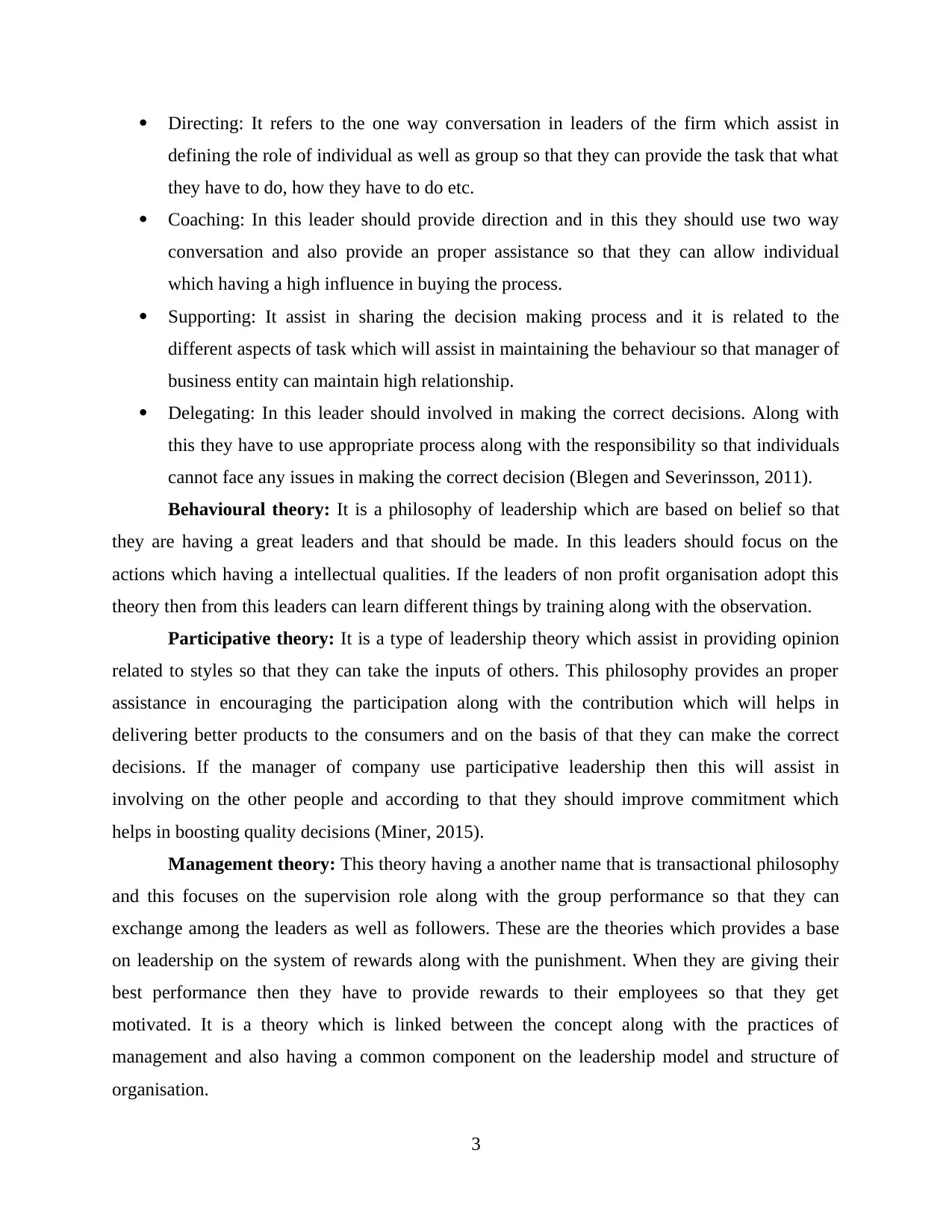
Directing: It refers to the one way conversation in leaders of the firm which assist in
defining the role of individual as well as group so that they can provide the task that what
they have to do, how they have to do etc.
Coaching: In this leader should provide direction and in this they should use two way
conversation and also provide an proper assistance so that they can allow individual
which having a high influence in buying the process.
Supporting: It assist in sharing the decision making process and it is related to the
different aspects of task which will assist in maintaining the behaviour so that manager of
business entity can maintain high relationship.
Delegating: In this leader should involved in making the correct decisions. Along with
this they have to use appropriate process along with the responsibility so that individuals
cannot face any issues in making the correct decision (Blegen and Severinsson, 2011).
Behavioural theory: It is a philosophy of leadership which are based on belief so that
they are having a great leaders and that should be made. In this leaders should focus on the
actions which having a intellectual qualities. If the leaders of non profit organisation adopt this
theory then from this leaders can learn different things by training along with the observation.
Participative theory: It is a type of leadership theory which assist in providing opinion
related to styles so that they can take the inputs of others. This philosophy provides an proper
assistance in encouraging the participation along with the contribution which will helps in
delivering better products to the consumers and on the basis of that they can make the correct
decisions. If the manager of company use participative leadership then this will assist in
involving on the other people and according to that they should improve commitment which
helps in boosting quality decisions (Miner, 2015).
Management theory: This theory having a another name that is transactional philosophy
and this focuses on the supervision role along with the group performance so that they can
exchange among the leaders as well as followers. These are the theories which provides a base
on leadership on the system of rewards along with the punishment. When they are giving their
best performance then they have to provide rewards to their employees so that they get
motivated. It is a theory which is linked between the concept along with the practices of
management and also having a common component on the leadership model and structure of
organisation.
3
defining the role of individual as well as group so that they can provide the task that what
they have to do, how they have to do etc.
Coaching: In this leader should provide direction and in this they should use two way
conversation and also provide an proper assistance so that they can allow individual
which having a high influence in buying the process.
Supporting: It assist in sharing the decision making process and it is related to the
different aspects of task which will assist in maintaining the behaviour so that manager of
business entity can maintain high relationship.
Delegating: In this leader should involved in making the correct decisions. Along with
this they have to use appropriate process along with the responsibility so that individuals
cannot face any issues in making the correct decision (Blegen and Severinsson, 2011).
Behavioural theory: It is a philosophy of leadership which are based on belief so that
they are having a great leaders and that should be made. In this leaders should focus on the
actions which having a intellectual qualities. If the leaders of non profit organisation adopt this
theory then from this leaders can learn different things by training along with the observation.
Participative theory: It is a type of leadership theory which assist in providing opinion
related to styles so that they can take the inputs of others. This philosophy provides an proper
assistance in encouraging the participation along with the contribution which will helps in
delivering better products to the consumers and on the basis of that they can make the correct
decisions. If the manager of company use participative leadership then this will assist in
involving on the other people and according to that they should improve commitment which
helps in boosting quality decisions (Miner, 2015).
Management theory: This theory having a another name that is transactional philosophy
and this focuses on the supervision role along with the group performance so that they can
exchange among the leaders as well as followers. These are the theories which provides a base
on leadership on the system of rewards along with the punishment. When they are giving their
best performance then they have to provide rewards to their employees so that they get
motivated. It is a theory which is linked between the concept along with the practices of
management and also having a common component on the leadership model and structure of
organisation.
3
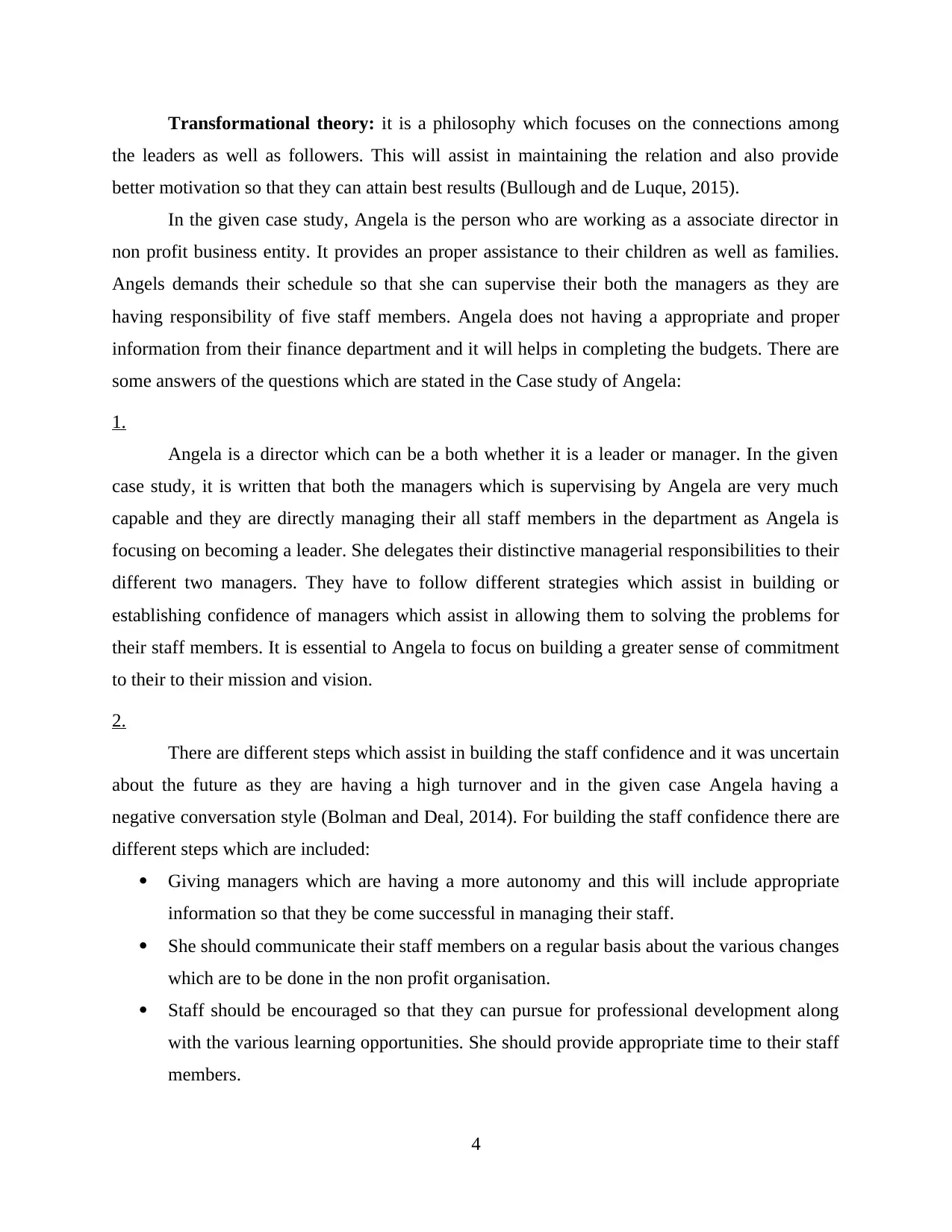
Transformational theory: it is a philosophy which focuses on the connections among
the leaders as well as followers. This will assist in maintaining the relation and also provide
better motivation so that they can attain best results (Bullough and de Luque, 2015).
In the given case study, Angela is the person who are working as a associate director in
non profit business entity. It provides an proper assistance to their children as well as families.
Angels demands their schedule so that she can supervise their both the managers as they are
having responsibility of five staff members. Angela does not having a appropriate and proper
information from their finance department and it will helps in completing the budgets. There are
some answers of the questions which are stated in the Case study of Angela:
1.
Angela is a director which can be a both whether it is a leader or manager. In the given
case study, it is written that both the managers which is supervising by Angela are very much
capable and they are directly managing their all staff members in the department as Angela is
focusing on becoming a leader. She delegates their distinctive managerial responsibilities to their
different two managers. They have to follow different strategies which assist in building or
establishing confidence of managers which assist in allowing them to solving the problems for
their staff members. It is essential to Angela to focus on building a greater sense of commitment
to their to their mission and vision.
2.
There are different steps which assist in building the staff confidence and it was uncertain
about the future as they are having a high turnover and in the given case Angela having a
negative conversation style (Bolman and Deal, 2014). For building the staff confidence there are
different steps which are included:
Giving managers which are having a more autonomy and this will include appropriate
information so that they be come successful in managing their staff.
She should communicate their staff members on a regular basis about the various changes
which are to be done in the non profit organisation.
Staff should be encouraged so that they can pursue for professional development along
with the various learning opportunities. She should provide appropriate time to their staff
members.
4
the leaders as well as followers. This will assist in maintaining the relation and also provide
better motivation so that they can attain best results (Bullough and de Luque, 2015).
In the given case study, Angela is the person who are working as a associate director in
non profit business entity. It provides an proper assistance to their children as well as families.
Angels demands their schedule so that she can supervise their both the managers as they are
having responsibility of five staff members. Angela does not having a appropriate and proper
information from their finance department and it will helps in completing the budgets. There are
some answers of the questions which are stated in the Case study of Angela:
1.
Angela is a director which can be a both whether it is a leader or manager. In the given
case study, it is written that both the managers which is supervising by Angela are very much
capable and they are directly managing their all staff members in the department as Angela is
focusing on becoming a leader. She delegates their distinctive managerial responsibilities to their
different two managers. They have to follow different strategies which assist in building or
establishing confidence of managers which assist in allowing them to solving the problems for
their staff members. It is essential to Angela to focus on building a greater sense of commitment
to their to their mission and vision.
2.
There are different steps which assist in building the staff confidence and it was uncertain
about the future as they are having a high turnover and in the given case Angela having a
negative conversation style (Bolman and Deal, 2014). For building the staff confidence there are
different steps which are included:
Giving managers which are having a more autonomy and this will include appropriate
information so that they be come successful in managing their staff.
She should communicate their staff members on a regular basis about the various changes
which are to be done in the non profit organisation.
Staff should be encouraged so that they can pursue for professional development along
with the various learning opportunities. She should provide appropriate time to their staff
members.
4
⊘ This is a preview!⊘
Do you want full access?
Subscribe today to unlock all pages.

Trusted by 1+ million students worldwide
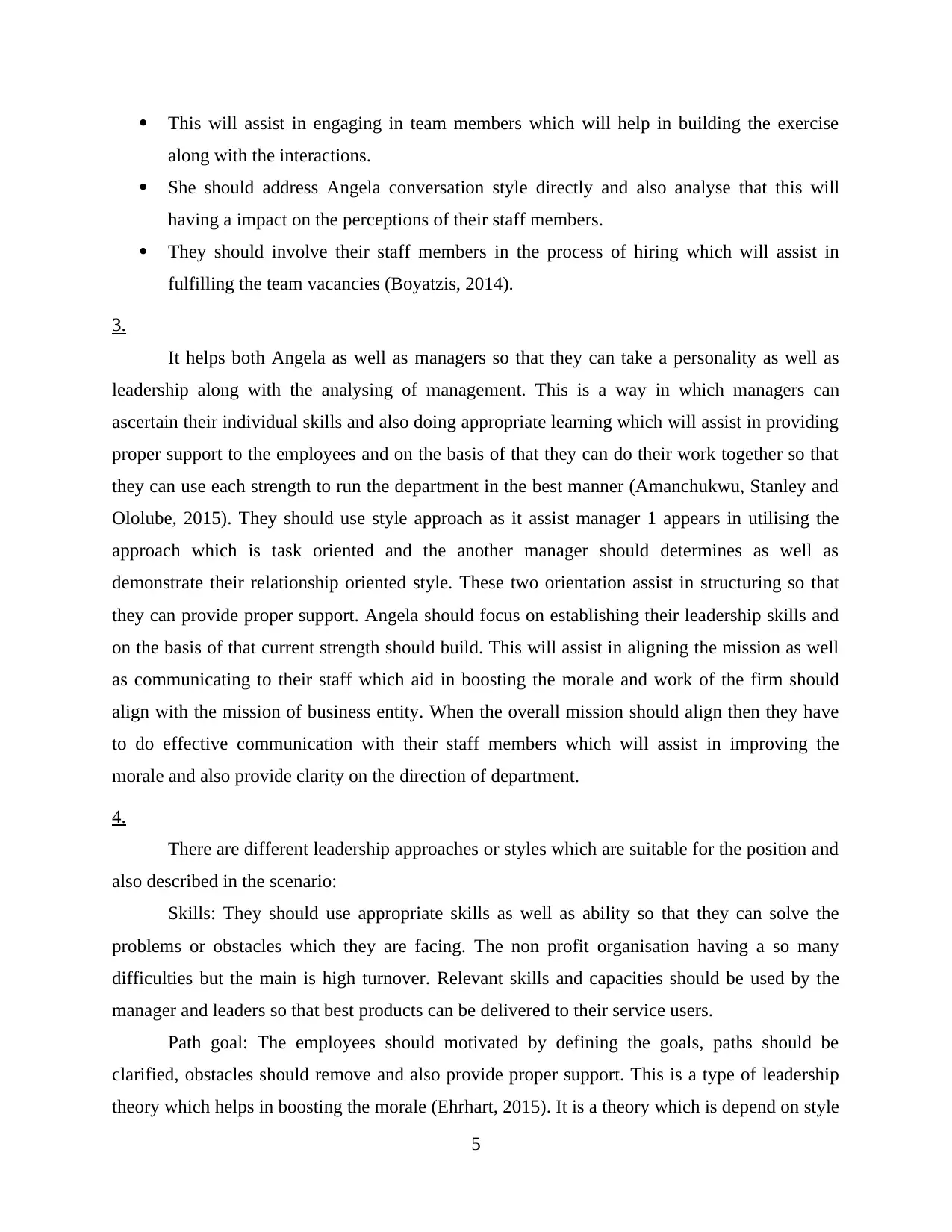
This will assist in engaging in team members which will help in building the exercise
along with the interactions.
She should address Angela conversation style directly and also analyse that this will
having a impact on the perceptions of their staff members.
They should involve their staff members in the process of hiring which will assist in
fulfilling the team vacancies (Boyatzis, 2014).
3.
It helps both Angela as well as managers so that they can take a personality as well as
leadership along with the analysing of management. This is a way in which managers can
ascertain their individual skills and also doing appropriate learning which will assist in providing
proper support to the employees and on the basis of that they can do their work together so that
they can use each strength to run the department in the best manner (Amanchukwu, Stanley and
Ololube, 2015). They should use style approach as it assist manager 1 appears in utilising the
approach which is task oriented and the another manager should determines as well as
demonstrate their relationship oriented style. These two orientation assist in structuring so that
they can provide proper support. Angela should focus on establishing their leadership skills and
on the basis of that current strength should build. This will assist in aligning the mission as well
as communicating to their staff which aid in boosting the morale and work of the firm should
align with the mission of business entity. When the overall mission should align then they have
to do effective communication with their staff members which will assist in improving the
morale and also provide clarity on the direction of department.
4.
There are different leadership approaches or styles which are suitable for the position and
also described in the scenario:
Skills: They should use appropriate skills as well as ability so that they can solve the
problems or obstacles which they are facing. The non profit organisation having a so many
difficulties but the main is high turnover. Relevant skills and capacities should be used by the
manager and leaders so that best products can be delivered to their service users.
Path goal: The employees should motivated by defining the goals, paths should be
clarified, obstacles should remove and also provide proper support. This is a type of leadership
theory which helps in boosting the morale (Ehrhart, 2015). It is a theory which is depend on style
5
along with the interactions.
She should address Angela conversation style directly and also analyse that this will
having a impact on the perceptions of their staff members.
They should involve their staff members in the process of hiring which will assist in
fulfilling the team vacancies (Boyatzis, 2014).
3.
It helps both Angela as well as managers so that they can take a personality as well as
leadership along with the analysing of management. This is a way in which managers can
ascertain their individual skills and also doing appropriate learning which will assist in providing
proper support to the employees and on the basis of that they can do their work together so that
they can use each strength to run the department in the best manner (Amanchukwu, Stanley and
Ololube, 2015). They should use style approach as it assist manager 1 appears in utilising the
approach which is task oriented and the another manager should determines as well as
demonstrate their relationship oriented style. These two orientation assist in structuring so that
they can provide proper support. Angela should focus on establishing their leadership skills and
on the basis of that current strength should build. This will assist in aligning the mission as well
as communicating to their staff which aid in boosting the morale and work of the firm should
align with the mission of business entity. When the overall mission should align then they have
to do effective communication with their staff members which will assist in improving the
morale and also provide clarity on the direction of department.
4.
There are different leadership approaches or styles which are suitable for the position and
also described in the scenario:
Skills: They should use appropriate skills as well as ability so that they can solve the
problems or obstacles which they are facing. The non profit organisation having a so many
difficulties but the main is high turnover. Relevant skills and capacities should be used by the
manager and leaders so that best products can be delivered to their service users.
Path goal: The employees should motivated by defining the goals, paths should be
clarified, obstacles should remove and also provide proper support. This is a type of leadership
theory which helps in boosting the morale (Ehrhart, 2015). It is a theory which is depend on style
5
Paraphrase This Document
Need a fresh take? Get an instant paraphrase of this document with our AI Paraphraser
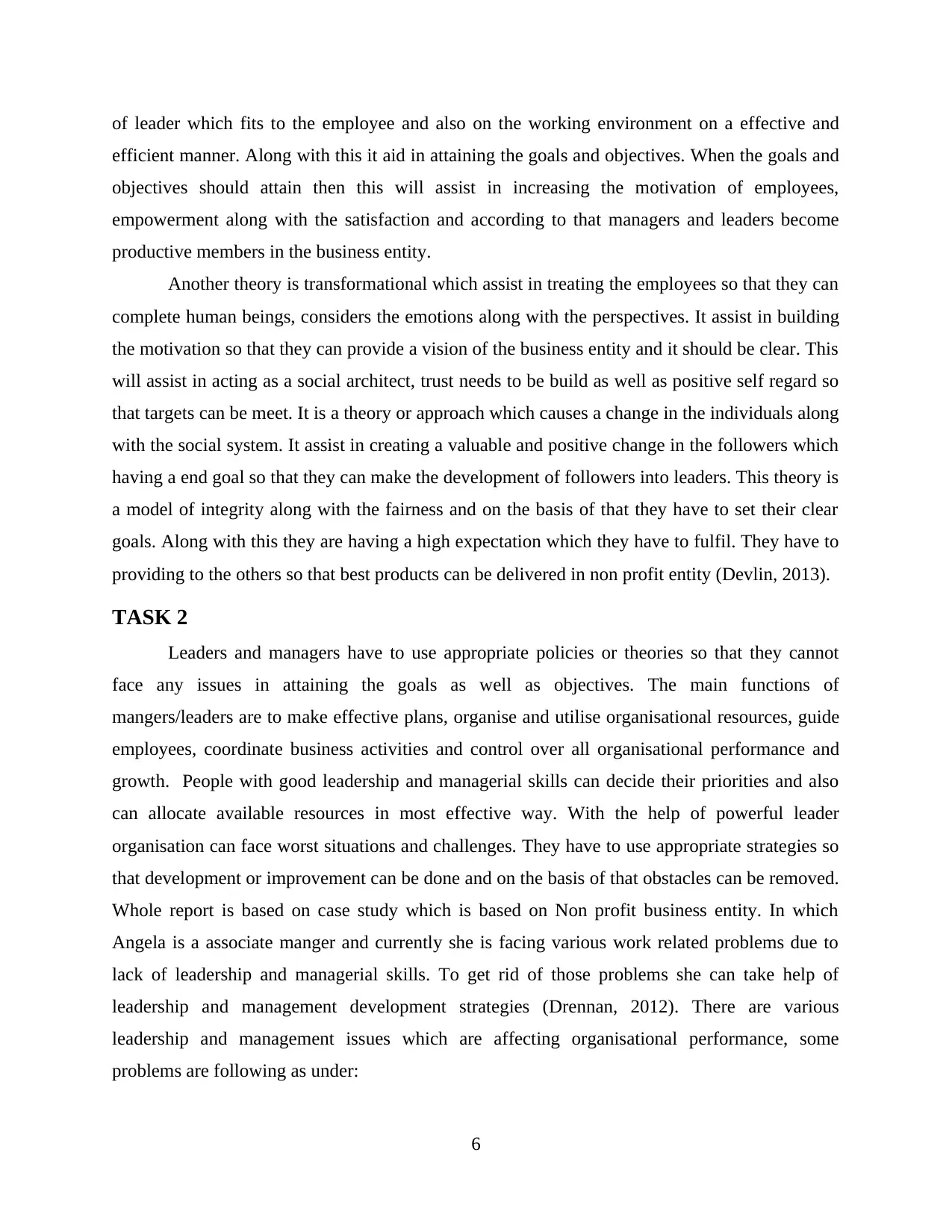
of leader which fits to the employee and also on the working environment on a effective and
efficient manner. Along with this it aid in attaining the goals and objectives. When the goals and
objectives should attain then this will assist in increasing the motivation of employees,
empowerment along with the satisfaction and according to that managers and leaders become
productive members in the business entity.
Another theory is transformational which assist in treating the employees so that they can
complete human beings, considers the emotions along with the perspectives. It assist in building
the motivation so that they can provide a vision of the business entity and it should be clear. This
will assist in acting as a social architect, trust needs to be build as well as positive self regard so
that targets can be meet. It is a theory or approach which causes a change in the individuals along
with the social system. It assist in creating a valuable and positive change in the followers which
having a end goal so that they can make the development of followers into leaders. This theory is
a model of integrity along with the fairness and on the basis of that they have to set their clear
goals. Along with this they are having a high expectation which they have to fulfil. They have to
providing to the others so that best products can be delivered in non profit entity (Devlin, 2013).
TASK 2
Leaders and managers have to use appropriate policies or theories so that they cannot
face any issues in attaining the goals as well as objectives. The main functions of
mangers/leaders are to make effective plans, organise and utilise organisational resources, guide
employees, coordinate business activities and control over all organisational performance and
growth. People with good leadership and managerial skills can decide their priorities and also
can allocate available resources in most effective way. With the help of powerful leader
organisation can face worst situations and challenges. They have to use appropriate strategies so
that development or improvement can be done and on the basis of that obstacles can be removed.
Whole report is based on case study which is based on Non profit business entity. In which
Angela is a associate manger and currently she is facing various work related problems due to
lack of leadership and managerial skills. To get rid of those problems she can take help of
leadership and management development strategies (Drennan, 2012). There are various
leadership and management issues which are affecting organisational performance, some
problems are following as under:
6
efficient manner. Along with this it aid in attaining the goals and objectives. When the goals and
objectives should attain then this will assist in increasing the motivation of employees,
empowerment along with the satisfaction and according to that managers and leaders become
productive members in the business entity.
Another theory is transformational which assist in treating the employees so that they can
complete human beings, considers the emotions along with the perspectives. It assist in building
the motivation so that they can provide a vision of the business entity and it should be clear. This
will assist in acting as a social architect, trust needs to be build as well as positive self regard so
that targets can be meet. It is a theory or approach which causes a change in the individuals along
with the social system. It assist in creating a valuable and positive change in the followers which
having a end goal so that they can make the development of followers into leaders. This theory is
a model of integrity along with the fairness and on the basis of that they have to set their clear
goals. Along with this they are having a high expectation which they have to fulfil. They have to
providing to the others so that best products can be delivered in non profit entity (Devlin, 2013).
TASK 2
Leaders and managers have to use appropriate policies or theories so that they cannot
face any issues in attaining the goals as well as objectives. The main functions of
mangers/leaders are to make effective plans, organise and utilise organisational resources, guide
employees, coordinate business activities and control over all organisational performance and
growth. People with good leadership and managerial skills can decide their priorities and also
can allocate available resources in most effective way. With the help of powerful leader
organisation can face worst situations and challenges. They have to use appropriate strategies so
that development or improvement can be done and on the basis of that obstacles can be removed.
Whole report is based on case study which is based on Non profit business entity. In which
Angela is a associate manger and currently she is facing various work related problems due to
lack of leadership and managerial skills. To get rid of those problems she can take help of
leadership and management development strategies (Drennan, 2012). There are various
leadership and management issues which are affecting organisational performance, some
problems are following as under:
6
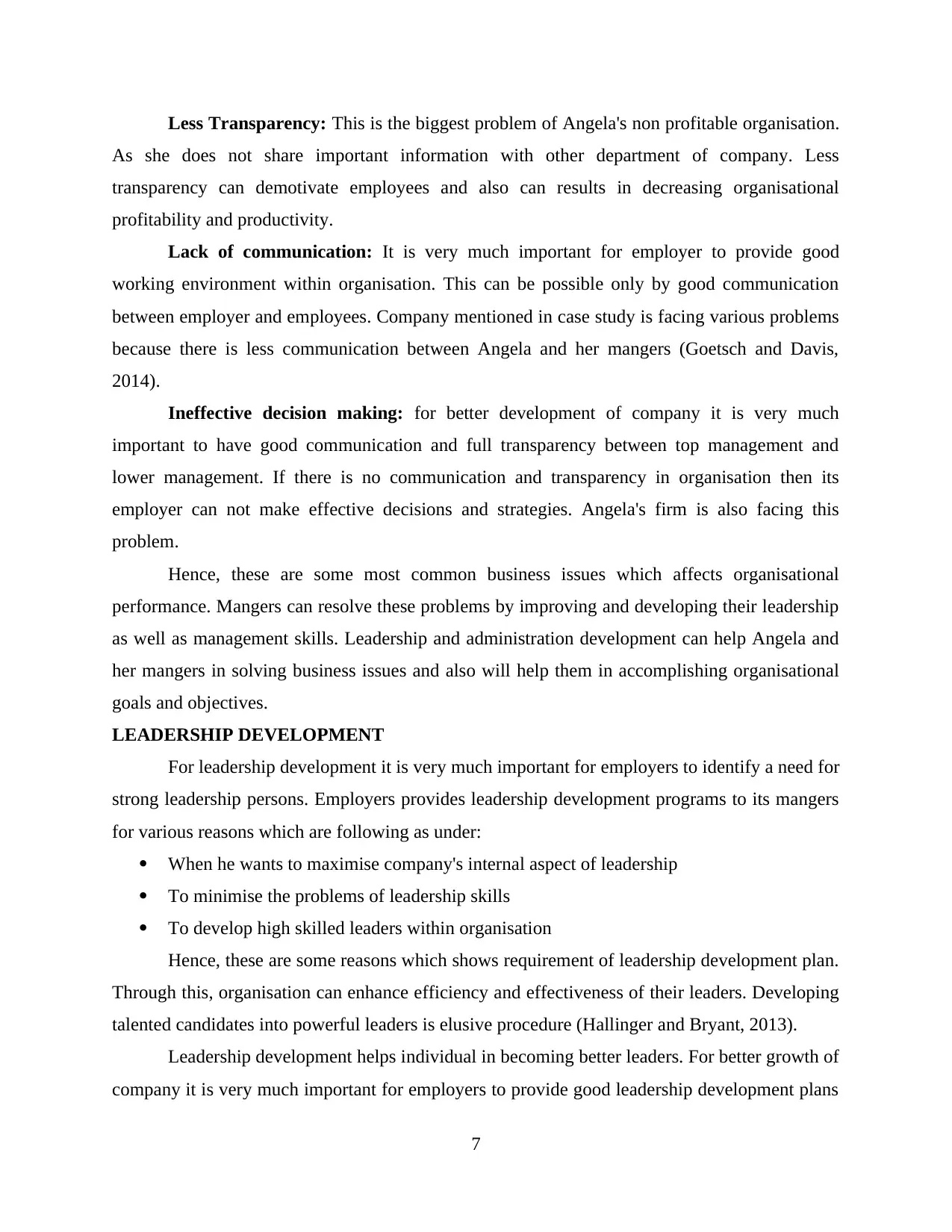
Less Transparency: This is the biggest problem of Angela's non profitable organisation.
As she does not share important information with other department of company. Less
transparency can demotivate employees and also can results in decreasing organisational
profitability and productivity.
Lack of communication: It is very much important for employer to provide good
working environment within organisation. This can be possible only by good communication
between employer and employees. Company mentioned in case study is facing various problems
because there is less communication between Angela and her mangers (Goetsch and Davis,
2014).
Ineffective decision making: for better development of company it is very much
important to have good communication and full transparency between top management and
lower management. If there is no communication and transparency in organisation then its
employer can not make effective decisions and strategies. Angela's firm is also facing this
problem.
Hence, these are some most common business issues which affects organisational
performance. Mangers can resolve these problems by improving and developing their leadership
as well as management skills. Leadership and administration development can help Angela and
her mangers in solving business issues and also will help them in accomplishing organisational
goals and objectives.
LEADERSHIP DEVELOPMENT
For leadership development it is very much important for employers to identify a need for
strong leadership persons. Employers provides leadership development programs to its mangers
for various reasons which are following as under:
When he wants to maximise company's internal aspect of leadership
To minimise the problems of leadership skills
To develop high skilled leaders within organisation
Hence, these are some reasons which shows requirement of leadership development plan.
Through this, organisation can enhance efficiency and effectiveness of their leaders. Developing
talented candidates into powerful leaders is elusive procedure (Hallinger and Bryant, 2013).
Leadership development helps individual in becoming better leaders. For better growth of
company it is very much important for employers to provide good leadership development plans
7
As she does not share important information with other department of company. Less
transparency can demotivate employees and also can results in decreasing organisational
profitability and productivity.
Lack of communication: It is very much important for employer to provide good
working environment within organisation. This can be possible only by good communication
between employer and employees. Company mentioned in case study is facing various problems
because there is less communication between Angela and her mangers (Goetsch and Davis,
2014).
Ineffective decision making: for better development of company it is very much
important to have good communication and full transparency between top management and
lower management. If there is no communication and transparency in organisation then its
employer can not make effective decisions and strategies. Angela's firm is also facing this
problem.
Hence, these are some most common business issues which affects organisational
performance. Mangers can resolve these problems by improving and developing their leadership
as well as management skills. Leadership and administration development can help Angela and
her mangers in solving business issues and also will help them in accomplishing organisational
goals and objectives.
LEADERSHIP DEVELOPMENT
For leadership development it is very much important for employers to identify a need for
strong leadership persons. Employers provides leadership development programs to its mangers
for various reasons which are following as under:
When he wants to maximise company's internal aspect of leadership
To minimise the problems of leadership skills
To develop high skilled leaders within organisation
Hence, these are some reasons which shows requirement of leadership development plan.
Through this, organisation can enhance efficiency and effectiveness of their leaders. Developing
talented candidates into powerful leaders is elusive procedure (Hallinger and Bryant, 2013).
Leadership development helps individual in becoming better leaders. For better growth of
company it is very much important for employers to provide good leadership development plans
7
⊘ This is a preview!⊘
Do you want full access?
Subscribe today to unlock all pages.

Trusted by 1+ million students worldwide
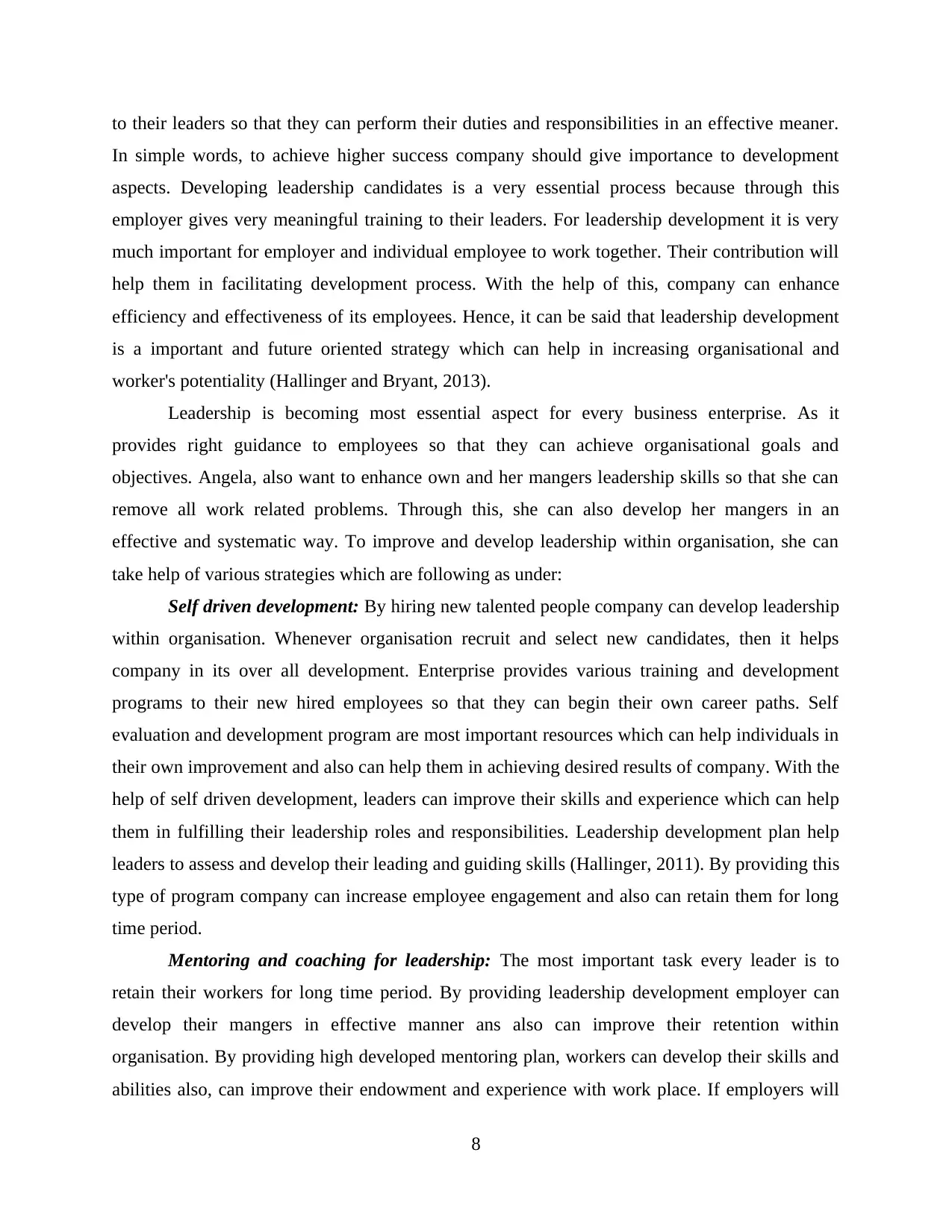
to their leaders so that they can perform their duties and responsibilities in an effective meaner.
In simple words, to achieve higher success company should give importance to development
aspects. Developing leadership candidates is a very essential process because through this
employer gives very meaningful training to their leaders. For leadership development it is very
much important for employer and individual employee to work together. Their contribution will
help them in facilitating development process. With the help of this, company can enhance
efficiency and effectiveness of its employees. Hence, it can be said that leadership development
is a important and future oriented strategy which can help in increasing organisational and
worker's potentiality (Hallinger and Bryant, 2013).
Leadership is becoming most essential aspect for every business enterprise. As it
provides right guidance to employees so that they can achieve organisational goals and
objectives. Angela, also want to enhance own and her mangers leadership skills so that she can
remove all work related problems. Through this, she can also develop her mangers in an
effective and systematic way. To improve and develop leadership within organisation, she can
take help of various strategies which are following as under:
Self driven development: By hiring new talented people company can develop leadership
within organisation. Whenever organisation recruit and select new candidates, then it helps
company in its over all development. Enterprise provides various training and development
programs to their new hired employees so that they can begin their own career paths. Self
evaluation and development program are most important resources which can help individuals in
their own improvement and also can help them in achieving desired results of company. With the
help of self driven development, leaders can improve their skills and experience which can help
them in fulfilling their leadership roles and responsibilities. Leadership development plan help
leaders to assess and develop their leading and guiding skills (Hallinger, 2011). By providing this
type of program company can increase employee engagement and also can retain them for long
time period.
Mentoring and coaching for leadership: The most important task every leader is to
retain their workers for long time period. By providing leadership development employer can
develop their mangers in effective manner ans also can improve their retention within
organisation. By providing high developed mentoring plan, workers can develop their skills and
abilities also, can improve their endowment and experience with work place. If employers will
8
In simple words, to achieve higher success company should give importance to development
aspects. Developing leadership candidates is a very essential process because through this
employer gives very meaningful training to their leaders. For leadership development it is very
much important for employer and individual employee to work together. Their contribution will
help them in facilitating development process. With the help of this, company can enhance
efficiency and effectiveness of its employees. Hence, it can be said that leadership development
is a important and future oriented strategy which can help in increasing organisational and
worker's potentiality (Hallinger and Bryant, 2013).
Leadership is becoming most essential aspect for every business enterprise. As it
provides right guidance to employees so that they can achieve organisational goals and
objectives. Angela, also want to enhance own and her mangers leadership skills so that she can
remove all work related problems. Through this, she can also develop her mangers in an
effective and systematic way. To improve and develop leadership within organisation, she can
take help of various strategies which are following as under:
Self driven development: By hiring new talented people company can develop leadership
within organisation. Whenever organisation recruit and select new candidates, then it helps
company in its over all development. Enterprise provides various training and development
programs to their new hired employees so that they can begin their own career paths. Self
evaluation and development program are most important resources which can help individuals in
their own improvement and also can help them in achieving desired results of company. With the
help of self driven development, leaders can improve their skills and experience which can help
them in fulfilling their leadership roles and responsibilities. Leadership development plan help
leaders to assess and develop their leading and guiding skills (Hallinger, 2011). By providing this
type of program company can increase employee engagement and also can retain them for long
time period.
Mentoring and coaching for leadership: The most important task every leader is to
retain their workers for long time period. By providing leadership development employer can
develop their mangers in effective manner ans also can improve their retention within
organisation. By providing high developed mentoring plan, workers can develop their skills and
abilities also, can improve their endowment and experience with work place. If employers will
8
Paraphrase This Document
Need a fresh take? Get an instant paraphrase of this document with our AI Paraphraser
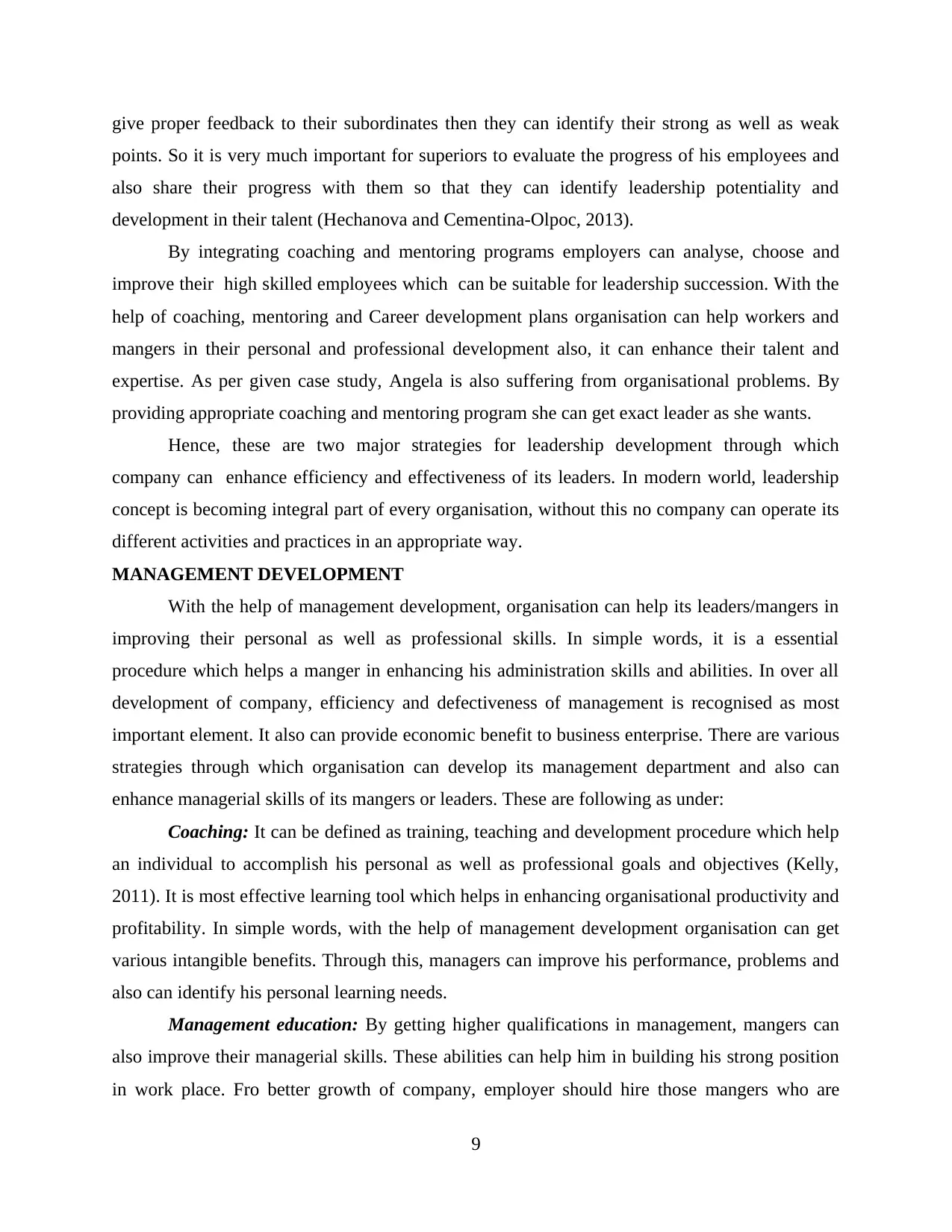
give proper feedback to their subordinates then they can identify their strong as well as weak
points. So it is very much important for superiors to evaluate the progress of his employees and
also share their progress with them so that they can identify leadership potentiality and
development in their talent (Hechanova and Cementina-Olpoc, 2013).
By integrating coaching and mentoring programs employers can analyse, choose and
improve their high skilled employees which can be suitable for leadership succession. With the
help of coaching, mentoring and Career development plans organisation can help workers and
mangers in their personal and professional development also, it can enhance their talent and
expertise. As per given case study, Angela is also suffering from organisational problems. By
providing appropriate coaching and mentoring program she can get exact leader as she wants.
Hence, these are two major strategies for leadership development through which
company can enhance efficiency and effectiveness of its leaders. In modern world, leadership
concept is becoming integral part of every organisation, without this no company can operate its
different activities and practices in an appropriate way.
MANAGEMENT DEVELOPMENT
With the help of management development, organisation can help its leaders/mangers in
improving their personal as well as professional skills. In simple words, it is a essential
procedure which helps a manger in enhancing his administration skills and abilities. In over all
development of company, efficiency and defectiveness of management is recognised as most
important element. It also can provide economic benefit to business enterprise. There are various
strategies through which organisation can develop its management department and also can
enhance managerial skills of its mangers or leaders. These are following as under:
Coaching: It can be defined as training, teaching and development procedure which help
an individual to accomplish his personal as well as professional goals and objectives (Kelly,
2011). It is most effective learning tool which helps in enhancing organisational productivity and
profitability. In simple words, with the help of management development organisation can get
various intangible benefits. Through this, managers can improve his performance, problems and
also can identify his personal learning needs.
Management education: By getting higher qualifications in management, mangers can
also improve their managerial skills. These abilities can help him in building his strong position
in work place. Fro better growth of company, employer should hire those mangers who are
9
points. So it is very much important for superiors to evaluate the progress of his employees and
also share their progress with them so that they can identify leadership potentiality and
development in their talent (Hechanova and Cementina-Olpoc, 2013).
By integrating coaching and mentoring programs employers can analyse, choose and
improve their high skilled employees which can be suitable for leadership succession. With the
help of coaching, mentoring and Career development plans organisation can help workers and
mangers in their personal and professional development also, it can enhance their talent and
expertise. As per given case study, Angela is also suffering from organisational problems. By
providing appropriate coaching and mentoring program she can get exact leader as she wants.
Hence, these are two major strategies for leadership development through which
company can enhance efficiency and effectiveness of its leaders. In modern world, leadership
concept is becoming integral part of every organisation, without this no company can operate its
different activities and practices in an appropriate way.
MANAGEMENT DEVELOPMENT
With the help of management development, organisation can help its leaders/mangers in
improving their personal as well as professional skills. In simple words, it is a essential
procedure which helps a manger in enhancing his administration skills and abilities. In over all
development of company, efficiency and defectiveness of management is recognised as most
important element. It also can provide economic benefit to business enterprise. There are various
strategies through which organisation can develop its management department and also can
enhance managerial skills of its mangers or leaders. These are following as under:
Coaching: It can be defined as training, teaching and development procedure which help
an individual to accomplish his personal as well as professional goals and objectives (Kelly,
2011). It is most effective learning tool which helps in enhancing organisational productivity and
profitability. In simple words, with the help of management development organisation can get
various intangible benefits. Through this, managers can improve his performance, problems and
also can identify his personal learning needs.
Management education: By getting higher qualifications in management, mangers can
also improve their managerial skills. These abilities can help him in building his strong position
in work place. Fro better growth of company, employer should hire those mangers who are
9
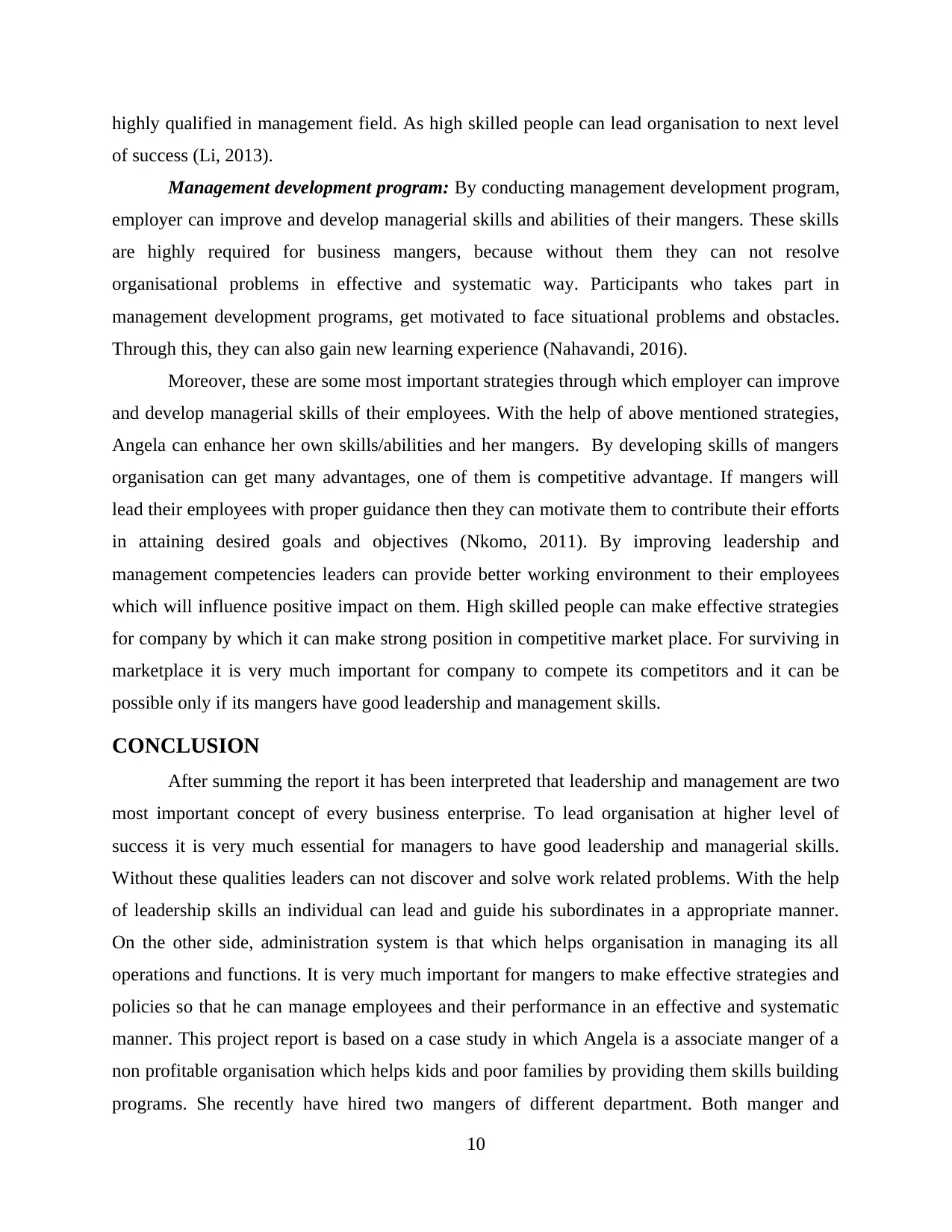
highly qualified in management field. As high skilled people can lead organisation to next level
of success (Li, 2013).
Management development program: By conducting management development program,
employer can improve and develop managerial skills and abilities of their mangers. These skills
are highly required for business mangers, because without them they can not resolve
organisational problems in effective and systematic way. Participants who takes part in
management development programs, get motivated to face situational problems and obstacles.
Through this, they can also gain new learning experience (Nahavandi, 2016).
Moreover, these are some most important strategies through which employer can improve
and develop managerial skills of their employees. With the help of above mentioned strategies,
Angela can enhance her own skills/abilities and her mangers. By developing skills of mangers
organisation can get many advantages, one of them is competitive advantage. If mangers will
lead their employees with proper guidance then they can motivate them to contribute their efforts
in attaining desired goals and objectives (Nkomo, 2011). By improving leadership and
management competencies leaders can provide better working environment to their employees
which will influence positive impact on them. High skilled people can make effective strategies
for company by which it can make strong position in competitive market place. For surviving in
marketplace it is very much important for company to compete its competitors and it can be
possible only if its mangers have good leadership and management skills.
CONCLUSION
After summing the report it has been interpreted that leadership and management are two
most important concept of every business enterprise. To lead organisation at higher level of
success it is very much essential for managers to have good leadership and managerial skills.
Without these qualities leaders can not discover and solve work related problems. With the help
of leadership skills an individual can lead and guide his subordinates in a appropriate manner.
On the other side, administration system is that which helps organisation in managing its all
operations and functions. It is very much important for mangers to make effective strategies and
policies so that he can manage employees and their performance in an effective and systematic
manner. This project report is based on a case study in which Angela is a associate manger of a
non profitable organisation which helps kids and poor families by providing them skills building
programs. She recently have hired two mangers of different department. Both manger and
10
of success (Li, 2013).
Management development program: By conducting management development program,
employer can improve and develop managerial skills and abilities of their mangers. These skills
are highly required for business mangers, because without them they can not resolve
organisational problems in effective and systematic way. Participants who takes part in
management development programs, get motivated to face situational problems and obstacles.
Through this, they can also gain new learning experience (Nahavandi, 2016).
Moreover, these are some most important strategies through which employer can improve
and develop managerial skills of their employees. With the help of above mentioned strategies,
Angela can enhance her own skills/abilities and her mangers. By developing skills of mangers
organisation can get many advantages, one of them is competitive advantage. If mangers will
lead their employees with proper guidance then they can motivate them to contribute their efforts
in attaining desired goals and objectives (Nkomo, 2011). By improving leadership and
management competencies leaders can provide better working environment to their employees
which will influence positive impact on them. High skilled people can make effective strategies
for company by which it can make strong position in competitive market place. For surviving in
marketplace it is very much important for company to compete its competitors and it can be
possible only if its mangers have good leadership and management skills.
CONCLUSION
After summing the report it has been interpreted that leadership and management are two
most important concept of every business enterprise. To lead organisation at higher level of
success it is very much essential for managers to have good leadership and managerial skills.
Without these qualities leaders can not discover and solve work related problems. With the help
of leadership skills an individual can lead and guide his subordinates in a appropriate manner.
On the other side, administration system is that which helps organisation in managing its all
operations and functions. It is very much important for mangers to make effective strategies and
policies so that he can manage employees and their performance in an effective and systematic
manner. This project report is based on a case study in which Angela is a associate manger of a
non profitable organisation which helps kids and poor families by providing them skills building
programs. She recently have hired two mangers of different department. Both manger and
10
⊘ This is a preview!⊘
Do you want full access?
Subscribe today to unlock all pages.

Trusted by 1+ million students worldwide
1 out of 15
Related Documents
Your All-in-One AI-Powered Toolkit for Academic Success.
+13062052269
info@desklib.com
Available 24*7 on WhatsApp / Email
![[object Object]](/_next/static/media/star-bottom.7253800d.svg)
Unlock your academic potential
Copyright © 2020–2025 A2Z Services. All Rights Reserved. Developed and managed by ZUCOL.



